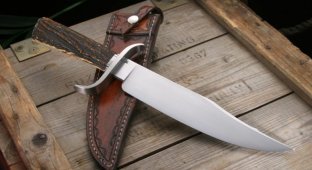For those who are interested, and not only them, I think it will be interesting...

The blade and its significance in tactical combat.
The blade, being the most important component of the knife, largely determines its use in tactical combat operations. The fact that the blade must be sharp to perform its main function is not only a truism, but also an indispensable condition, since only a sharp blade ensures confident handling of the knife.
If the blade is dull, the user tries to compensate by using more force, and the movements can be difficult to control, ultimately leading to accidents. Anyone who takes part in tactical operations understands that such circumstances can have catastrophic consequences.
But what more specific qualities, size and shape should the blade have? These and other questions cannot be answered unambiguously. Each professional has his own vision in this regard. The blade of a tactical combat knife should, if possible, be both a weapon and a tool, which is the main condition for this type of knife, as already discussed.

Under certain circumstances, it may happen that in a particular case a knife will be needed more as a weapon or, conversely, as a tool. In this regard, each buyer, taking into account the profile of his work or service, must determine for which tasks he will use his knife.
A folding knife with a sickle blade is unlikely to be suitable as a survival knife or diving knife. The material of the blade also plays a significant role here. Which alloys are more suitable, for example, for diving knives? If the future owner of a knife does not want to have unpleasant surprises during tactical operations, he must certainly take all these factors into account.
Steel is no longer the only material for making blades. Modern materials such as titanium, ceramics or plastic open up wide possibilities for using knives, which were not even thought of a few years ago.
The next factors that determine the particular use of the blade are, for example, wave-shaped sharpening and teeth. Since the Spiderco company began supplying its knives with a wave-shaped sharpening in the early 80s, the latter has become an integral attribute of tactical combat knives. Of course, there are conflicting opinions on this issue, for example, about what configuration the wave-shaped sharpening should be and on which side of the blade it should be located.
To prevent the blades from reflecting and thereby being conspicuous, the surface of the blades of tactical knives is subjected to special treatment. The topic of Damascus steel is deliberately not touched upon, since for tactical combat knives, unlike collectible knives, it does not have any significance. There is special literature on this topic.

Shapes, geometric structure and construction
The type and shape of the blade play a decisive role when buying a knife, and manufacturing companies do not miss an opportunity to emphasize these factors in advertising their products. Unfortunately, all the more daring and avant-garde blade shapes do not have the same significance despite the great difference in their application. Many companies are trying to use such blades to simply stand out among their competitors.
The scope of this article, unfortunately, does not allow us to demonstrate all the shapes of blades in their various modifications, moreover, this would be quite risky, since often it is enough to lengthen a line or slightly change the radius, and the overall impression of the blade changes.
Successful knife models are often copied by other companies and, when sold, are passed off as their own products. We will limit ourselves to a description of the typical blade shapes that prevail in tactical combat knives, their geometric structure and design.
Tanto form

This blade shape was born in the fascinating world of Japanese edged weapons and over time simply became a symbol of a tactical combat knife. The reason for this is the extreme stability of the blade's tip. The thickness of the blade remains massive almost to the very tip, which allows it to pierce fairly strong objects without the risk of damaging the tip. For tactical combat knives, Tanto blades are divided into two groups: blades with a concave or wedge-shaped regular sharpening on both sides and blades with sharpening in the form of a chisel.
Drop point form

A blade with a “Drop point” shape (a blade with a drop-shaped tip) is characteristic, in fact, of hunting knives, and was originally conceived as a tool, not a weapon. As a rule, such knives do not have a blade on the butt of the blade. Knives with such blades are multifunctional assistants in the field.
Spear Point form

A blade with a “Spear Point” shape (spear tip), just like a “Tanto” blade, is particularly resistant in the tip area. Unlike the Bowie shape, which has a thin tip due to the concave curvature of the spine, the convex Spear Point blade, due to the outward curve, remains massive right up to the tip, which can withstand heavy loads.
Bowie uniform

Named for Texas national hero James Bowie and designed in the 19th century for a combat knife, the Bowie blade, with its classic duckbill point, straddles the line between tool and weapon. The blade on the butt can be curved or straight, and, as a rule, also has a sharpening, due to which the same effect is achieved during a strike as during a strike with a dagger-shaped blade.
Form "Dagger"

Although it is constantly pointed out that the dagger-shaped blade lacks wide application possibilities, such a blade can still be used in tactical operations. The advantage of a symmetrical blade during combat is obvious: it allows for a large number of tactical maneuvers with the knife. The knife can be moved both down and up without rotating the handle in the hand. If the knife is used in the dark, you don't need to worry about whether the blade is up or down. Due to the double-edged blade, penetration is relatively easy, so this shape is primarily suitable for piercing blows. A blade with this shape is still only used conditionally as a tool. Thanks to the four-line sharpening, the blade is relatively light, so it is not suitable for chopping wood or using it as a lever. Additional pressure with the other hand on the butt of the blade is also impossible.
Hawkbill form

The Hawkbill shape (sickle shape) may appear to be more dangerous than it actually is. A blade with this shape is used primarily as a tool and is excellent for cutting cables and belts. Such a blade is hardly suitable for piercing blows or direct cutting, but despite this, its danger should not be underestimated.
Geometric structure of the blade.
Along with the shape of the blade, its geometric structure also has a significant impact on the efficiency of use. The user must also think in advance about the loads his knife will be subjected to.
Wedge-shaped or, otherwise, conical sharpening is best suited for blades that experience heavy loads, for example, when splitting wood or when using the blade as a lever. In cross-section, such a sharpening has the shape of a wedge, as its name already suggests. From the blade, the blade thickens upward. The ratio between the width and thickness of the blade determines the effectiveness of using the knife. The thinner the wedge, the less waste during cutting, the better the blade cuts. But at the same time, a thin blade means less strength, and vice versa, a thicker blade with a wider wedge is more durable, however, to achieve the best cutting effect in this case, the sharpening angle of the blade must be very sharp. The more the blade is ground down over time, the more material is removed from the tip of the wedge-shaped blade during subsequent sharpening, as a result of which the blade becomes wider and may reflect, which is undesirable. In principle, wedge-shaped sharpening is recommended for knives intended for heavy loads on the blade. Thanks to modern program-controlled grinding systems, there are endless possibilities for creating wedge sharpening in all possible shapes.

Fuller sharpening, also known as razor sharpening, involves a narrow, very sharp blade that is relatively easy to sharpen later. The disadvantage here is less strength compared to wedge sharpening. The fuller sharpening very rarely extends across the entire width of the blade right up to the spine. In most cases, a blade with a fuller sharpening is filled with a massive spine, which ensures the strength of the blade. Only those blades that are intended primarily for cutting, but not for splitting or for using the knife as a lever, should have a fuller sharpening. Even if the blade does not break during such work, the thin blade can be seriously damaged.
Sharpening in the form of a chisel.
When sharpening in the form of a chisel, we are talking about a one-sided wedge-shaped sharpening, which is characteristic of Japanese kitchen knives. The question of which side the blade should be sharpened on is a bone of contention among knife design experts. If you make a horizontal cut, you can see that it really doesn’t matter which side the blade is sharpened on. If you need to work with the blade away from you, then some problems quickly arise. When processing wood, the carpenter constantly holds the chisel in such a way that the sharpened side of the blade faces upward, which allows the material to be processed to be removed. The same principle can be applied to a blade that has a chisel-shaped sharpening. If the user is right-handed, then the sharpening should be located on the right side of the blade, when looking at the butt. For a left-hander, everything should be the other way around. Unfortunately, manufacturing companies and knife makers pay too little attention to this circumstance, although there are rare exceptions, such as the Canadian master Greg Lightfoot.
Convex sharpening.
Convex sharpening is used primarily for ax blades, and is practically never found in tactical combat knives. A rare exception here is the handcrafted Smatchet by master craftsman Bill Harsey, who deliberately chose this form of sharpening since the knife is primarily used as a cleaver.

Design.
For the stability of a knife, its design is a decisive factor. Tactical combat knives use three tang shapes.
Short shank.
This shank is only slightly recessed into the handle (Cut Down Tang) and is secured in it with glue, a cross pin or a screw. A typical example of this design is hollow-handled survival knives.

Round shank.
This shank runs through the entire handle (Round Tang) and is secured either with a screw or a pin on the pommel. With a screw fastening, it is possible to tighten the screw if the handle becomes loose, which is impossible with a pin fastening.

Flat shank.
This tang extends across the entire handle, and is either the same thickness along the entire length (Full Tang), or tapers towards the end of the handle (Tapered Tang). Of all types of shanks, this one is the most stable.

If someone intends to purchase a knife that can withstand maximum loads at the joints of individual elements, he should opt for the so-called integrated knife design, when the blade, cross, tang and pommel are made of one solid steel billet.
A good example of this design is the TAS-10 and TAS-11 models by master Tom Johanningen, as well as the Tactical knife by master Stefan Steigerwald.
"Modern combat knives"
D. Paul






















